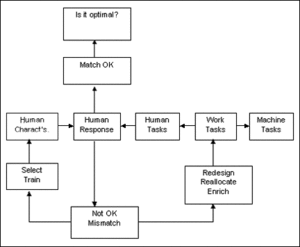Obviously, I'm going to take a few liberties with these two issues. I'm going to present my perspective of how others think, and discuss both the differences and the similarities in these viewpoints. As I indicated in my first column, the ergonomist is interested in matching the individual with his or her environment. While usually associated with the workplace, the word "ergonomics" has made it into virtually every aspect of our lives (e.g., ergonomic backpacks for kids). Also, as I stated earlier, it is actually an engineering discipline and often takes on a very mathematical slant.
With that in mind, from the ergonomist's point of view, everything begins with an evaluation of the task. Whether it's a work task or a non-work-related task, a clear understanding of the requirements of the task is essential. To appreciate this perspective, let's look at a common task most of us have probably performed at least once: changing a flat tire on a car. The first step in developing any ergonomic intervention for such a task is to break the task down into distinct, describable steps. For example, take a moment to list the individual tasks involved in changing a tire. How many can you come up with? A few examples of such individual components include:
- locating the lug wrench;
- retrieving the wrench from its location in the trunk of the car;
- securely attaching the wrench to the appropriate place on the undersurface of the car;
- placing the wrench on the lug nuts;
- loosening the lug nuts.
If you can identify almost 50 individual components that are part of this specific task, you're close.
Once all of the steps have been identified, decisions may be made regarding necessary modifications. An important question for the ergonomist is: "Should the task be performed by a person or by a machine?" If you are changing the tire on your own car, the answer is obvious -You're going to do it manually. However, if you're working on an assembly line and your job is to continually change tires throughout the workday, there may be steps that are better done by a machine. As an example, your mechanic will probably use a power torque wrench to loosen or tighten the lug nuts.
If the task is best performed by a human, the next question for the ergonomist involves the human response. In other words, "How does the human machine respond to the demands of the task?" As stated earlier, performing a task one time (e.g., changing a tire) is probably well within the capabilities of the average person. However, repeating the task over and over hundreds or thousands of times each day may cause some physical problems. Are there strength or coordination demands that are required? If so, what will likely happen to the human machine with repeated exposure?
If there is a match between the task and the human response, another question may be addressed: "Is the match optimal?" In other words, can certain modifications make the task easier or less stressful? Would a better wrench enable you to remove the lug nuts with greater ease? Or, would a different type of wrench enable an individual with arthritic hands to also perform the task? If this is the case, the ergonomist may work with the manufacturer of the torque wrench to insure that the handle is adequately designed, the weight of the tool is acceptable, and the vibration levels are within tolerable limits.
On the other hand, if there is a mismatch between the task and the human response, the ergonomist will ask:
- Can we select and train individuals in order to reduce the mismatch?
- What specific characteristics are required to perform the task?
- If the task requires hand strength, should strength testing be performed prior to an offer of employment, and if so, would rheumatoid arthritis of the hands, or a history of carpal tunnel syndrome, prevent someone from getting a job that includes the task? Obviously, that could be a violation of the Americans with Disabilities Act (ADA).
Selecting individuals who are able to perform all aspects of a given job requires a clear understanding of the tasks involved. In fact, according to the ADA, it is illegal to not hire someone if he or she can perform the "essential functions" of a job "with or without some reasonable accommodation." Breaking jobs down into essential functions and developing reasonable accommodations often falls within the purview of the ergonomist.
I have included a flow chart from the University of Surrey above. It clearly defines the process in an "engineering" sort of way. Next time, we'll look at ergonomics from the clinician's point of view. Ultimately, the goals are the same, but the thought process is quite different.
Paul Hooper, DC, MPH
Diamond Bar, California
Click here for previous articles by Paul Hooper, DC, MPH, MS.






